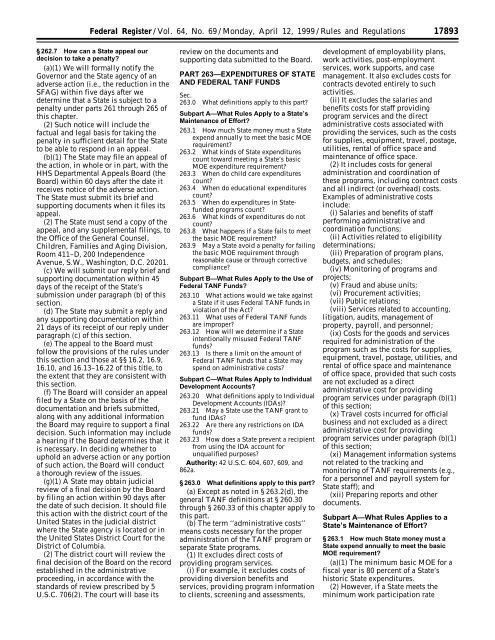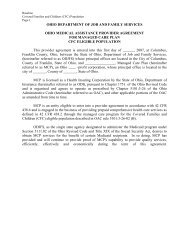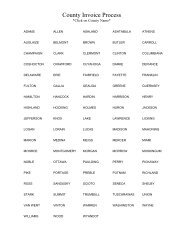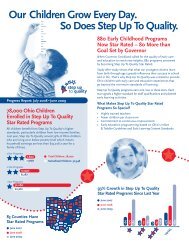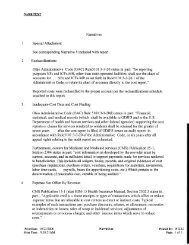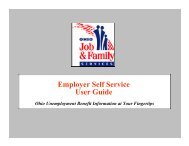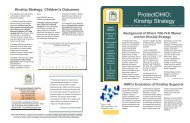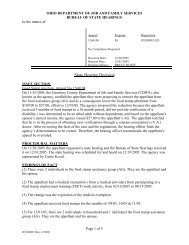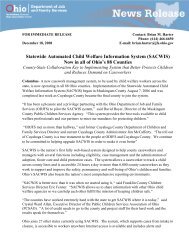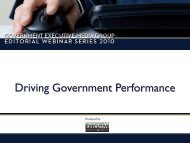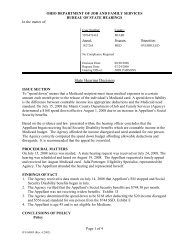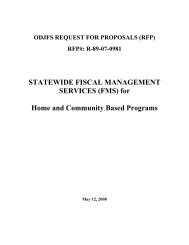Final TANF Rule as published in the Federal Register 4/12/1999
Final TANF Rule as published in the Federal Register 4/12/1999
Final TANF Rule as published in the Federal Register 4/12/1999
Create successful ePaper yourself
Turn your PDF publications into a flip-book with our unique Google optimized e-Paper software.
<strong>Federal</strong> <strong>Register</strong> / Vol. 64, No. 69 / Monday, April <strong>12</strong>, <strong>1999</strong> / <strong>Rule</strong>s and Regulations<br />
§ 262.7 How can a State appeal our<br />
decision to take a penalty?<br />
(a)(1) We will formally notify <strong>the</strong><br />
Governor and <strong>the</strong> State agency of an<br />
adverse action (i.e., <strong>the</strong> reduction <strong>in</strong> <strong>the</strong><br />
SFAG) with<strong>in</strong> five days after we<br />
determ<strong>in</strong>e that a State is subject to a<br />
penalty under parts 261 through 265 of<br />
this chapter.<br />
(2) Such notice will <strong>in</strong>clude <strong>the</strong><br />
factual and legal b<strong>as</strong>is for tak<strong>in</strong>g <strong>the</strong><br />
penalty <strong>in</strong> sufficient detail for <strong>the</strong> State<br />
to be able to respond <strong>in</strong> an appeal.<br />
(b)(1) The State may file an appeal of<br />
<strong>the</strong> action, <strong>in</strong> whole or <strong>in</strong> part, with <strong>the</strong><br />
HHS Departmental Appeals Board (<strong>the</strong><br />
Board) with<strong>in</strong> 60 days after <strong>the</strong> date it<br />
receives notice of <strong>the</strong> adverse action.<br />
The State must submit its brief and<br />
support<strong>in</strong>g documents when it files its<br />
appeal.<br />
(2) The State must send a copy of <strong>the</strong><br />
appeal, and any supplemental fil<strong>in</strong>gs, to<br />
<strong>the</strong> Office of <strong>the</strong> General Counsel,<br />
Children, Families and Ag<strong>in</strong>g Division,<br />
Room 411–D, 200 Independence<br />
Avenue, S.W., W<strong>as</strong>h<strong>in</strong>gton, D.C. 20201.<br />
(c) We will submit our reply brief and<br />
support<strong>in</strong>g documentation with<strong>in</strong> 45<br />
days of <strong>the</strong> receipt of <strong>the</strong> State’s<br />
submission under paragraph (b) of this<br />
section.<br />
(d) The State may submit a reply and<br />
any support<strong>in</strong>g documentation with<strong>in</strong><br />
21 days of its receipt of our reply under<br />
paragraph (c) of this section.<br />
(e) The appeal to <strong>the</strong> Board must<br />
follow <strong>the</strong> provisions of <strong>the</strong> rules under<br />
this section and those at §§ 16.2, 16.9,<br />
16.10, and 16.13–16.22 of this title, to<br />
<strong>the</strong> extent that <strong>the</strong>y are consistent with<br />
this section.<br />
(f) The Board will consider an appeal<br />
filed by a State on <strong>the</strong> b<strong>as</strong>is of <strong>the</strong><br />
documentation and briefs submitted,<br />
along with any additional <strong>in</strong>formation<br />
<strong>the</strong> Board may require to support a f<strong>in</strong>al<br />
decision. Such <strong>in</strong>formation may <strong>in</strong>clude<br />
a hear<strong>in</strong>g if <strong>the</strong> Board determ<strong>in</strong>es that it<br />
is necessary. In decid<strong>in</strong>g whe<strong>the</strong>r to<br />
uphold an adverse action or any portion<br />
of such action, <strong>the</strong> Board will conduct<br />
a thorough review of <strong>the</strong> issues.<br />
(g)(1) A State may obta<strong>in</strong> judicial<br />
review of a f<strong>in</strong>al decision by <strong>the</strong> Board<br />
by fil<strong>in</strong>g an action with<strong>in</strong> 90 days after<br />
<strong>the</strong> date of such decision. It should file<br />
this action with <strong>the</strong> district court of <strong>the</strong><br />
United States <strong>in</strong> <strong>the</strong> judicial district<br />
where <strong>the</strong> State agency is located or <strong>in</strong><br />
<strong>the</strong> United States District Court for <strong>the</strong><br />
District of Columbia.<br />
(2) The district court will review <strong>the</strong><br />
f<strong>in</strong>al decision of <strong>the</strong> Board on <strong>the</strong> record<br />
established <strong>in</strong> <strong>the</strong> adm<strong>in</strong>istrative<br />
proceed<strong>in</strong>g, <strong>in</strong> accordance with <strong>the</strong><br />
standards of review prescribed by 5<br />
U.S.C. 706(2). The court will b<strong>as</strong>e its<br />
review on <strong>the</strong> documents and<br />
support<strong>in</strong>g data submitted to <strong>the</strong> Board.<br />
PART 263—EXPENDITURES OF STATE<br />
AND FEDERAL <strong>TANF</strong> FUNDS<br />
Sec.<br />
263.0 What def<strong>in</strong>itions apply to this part?<br />
Subpart A—What <strong>Rule</strong>s Apply to a State’s<br />
Ma<strong>in</strong>tenance of Effort?<br />
263.1 How much State money must a State<br />
expend annually to meet <strong>the</strong> b<strong>as</strong>ic MOE<br />
requirement?<br />
263.2 What k<strong>in</strong>ds of State expenditures<br />
count toward meet<strong>in</strong>g a State’s b<strong>as</strong>ic<br />
MOE expenditure requirement?<br />
263.3 When do child care expenditures<br />
count?<br />
263.4 When do educational expenditures<br />
count?<br />
263.5 When do expenditures <strong>in</strong> Statefunded<br />
programs count?<br />
263.6 What k<strong>in</strong>ds of expenditures do not<br />
count?<br />
263.8 What happens if a State fails to meet<br />
<strong>the</strong> b<strong>as</strong>ic MOE requirement?<br />
263.9 May a State avoid a penalty for fail<strong>in</strong>g<br />
<strong>the</strong> b<strong>as</strong>ic MOE requirement through<br />
re<strong>as</strong>onable cause or through corrective<br />
compliance?<br />
Subpart B—What <strong>Rule</strong>s Apply to <strong>the</strong> Use of<br />
<strong>Federal</strong> <strong>TANF</strong> Funds?<br />
263.10 What actions would we take aga<strong>in</strong>st<br />
a State if it uses <strong>Federal</strong> <strong>TANF</strong> funds <strong>in</strong><br />
violation of <strong>the</strong> Act?<br />
263.11 What uses of <strong>Federal</strong> <strong>TANF</strong> funds<br />
are improper?<br />
263.<strong>12</strong> How will we determ<strong>in</strong>e if a State<br />
<strong>in</strong>tentionally misused <strong>Federal</strong> <strong>TANF</strong><br />
funds?<br />
263.13 Is <strong>the</strong>re a limit on <strong>the</strong> amount of<br />
<strong>Federal</strong> <strong>TANF</strong> funds that a State may<br />
spend on adm<strong>in</strong>istrative costs?<br />
Subpart C—What <strong>Rule</strong>s Apply to Individual<br />
Development Accounts?<br />
263.20 What def<strong>in</strong>itions apply to Individual<br />
Development Accounts (IDAs)?<br />
263.21 May a State use <strong>the</strong> <strong>TANF</strong> grant to<br />
fund IDAs?<br />
263.22 Are <strong>the</strong>re any restrictions on IDA<br />
funds?<br />
263.23 How does a State prevent a recipient<br />
from us<strong>in</strong>g <strong>the</strong> IDA account for<br />
unqualified purposes?<br />
Authority: 42 U.S.C. 604, 607, 609, and<br />
862a.<br />
§ 263.0 What def<strong>in</strong>itions apply to this part?<br />
(a) Except <strong>as</strong> noted <strong>in</strong> § 263.2(d), <strong>the</strong><br />
general <strong>TANF</strong> def<strong>in</strong>itions at § 260.30<br />
through § 260.33 of this chapter apply to<br />
this part.<br />
(b) The term ‘‘adm<strong>in</strong>istrative costs’’<br />
means costs necessary for <strong>the</strong> proper<br />
adm<strong>in</strong>istration of <strong>the</strong> <strong>TANF</strong> program or<br />
separate State programs.<br />
(1) It excludes direct costs of<br />
provid<strong>in</strong>g program services.<br />
(i) For example, it excludes costs of<br />
provid<strong>in</strong>g diversion benefits and<br />
services, provid<strong>in</strong>g program <strong>in</strong>formation<br />
to clients, screen<strong>in</strong>g and <strong>as</strong>sessments,<br />
17893<br />
development of employability plans,<br />
work activities, post-employment<br />
services, work supports, and c<strong>as</strong>e<br />
management. It also excludes costs for<br />
contracts devoted entirely to such<br />
activities.<br />
(ii) It excludes <strong>the</strong> salaries and<br />
benefits costs for staff provid<strong>in</strong>g<br />
program services and <strong>the</strong> direct<br />
adm<strong>in</strong>istrative costs <strong>as</strong>sociated with<br />
provid<strong>in</strong>g <strong>the</strong> services, such <strong>as</strong> <strong>the</strong> costs<br />
for supplies, equipment, travel, postage,<br />
utilities, rental of office space and<br />
ma<strong>in</strong>tenance of office space.<br />
(2) It <strong>in</strong>cludes costs for general<br />
adm<strong>in</strong>istration and coord<strong>in</strong>ation of<br />
<strong>the</strong>se programs, <strong>in</strong>clud<strong>in</strong>g contract costs<br />
and all <strong>in</strong>direct (or overhead) costs.<br />
Examples of adm<strong>in</strong>istrative costs<br />
<strong>in</strong>clude:<br />
(i) Salaries and benefits of staff<br />
perform<strong>in</strong>g adm<strong>in</strong>istrative and<br />
coord<strong>in</strong>ation functions;<br />
(ii) Activities related to eligibility<br />
determ<strong>in</strong>ations;<br />
(iii) Preparation of program plans,<br />
budgets, and schedules;<br />
(iv) Monitor<strong>in</strong>g of programs and<br />
projects;<br />
(v) Fraud and abuse units;<br />
(vi) Procurement activities;<br />
(vii) Public relations;<br />
(viii) Services related to account<strong>in</strong>g,<br />
litigation, audits, management of<br />
property, payroll, and personnel;<br />
(ix) Costs for <strong>the</strong> goods and services<br />
required for adm<strong>in</strong>istration of <strong>the</strong><br />
program such <strong>as</strong> <strong>the</strong> costs for supplies,<br />
equipment, travel, postage, utilities, and<br />
rental of office space and ma<strong>in</strong>tenance<br />
of office space, provided that such costs<br />
are not excluded <strong>as</strong> a direct<br />
adm<strong>in</strong>istrative cost for provid<strong>in</strong>g<br />
program services under paragraph (b)(1)<br />
of this section;<br />
(x) Travel costs <strong>in</strong>curred for official<br />
bus<strong>in</strong>ess and not excluded <strong>as</strong> a direct<br />
adm<strong>in</strong>istrative cost for provid<strong>in</strong>g<br />
program services under paragraph (b)(1)<br />
of this section;<br />
(xi) Management <strong>in</strong>formation systems<br />
not related to <strong>the</strong> track<strong>in</strong>g and<br />
monitor<strong>in</strong>g of <strong>TANF</strong> requirements (e.g.,<br />
for a personnel and payroll system for<br />
State staff); and<br />
(xii) Prepar<strong>in</strong>g reports and o<strong>the</strong>r<br />
documents.<br />
Subpart A—What <strong>Rule</strong>s Applies to a<br />
State’s Ma<strong>in</strong>tenance of Effort?<br />
§ 263.1 How much State money must a<br />
State expend annually to meet <strong>the</strong> b<strong>as</strong>ic<br />
MOE requirement?<br />
(a)(1) The m<strong>in</strong>imum b<strong>as</strong>ic MOE for a<br />
fiscal year is 80 percent of a State’s<br />
historic State expenditures.<br />
(2) However, if a State meets <strong>the</strong><br />
m<strong>in</strong>imum work participation rate


